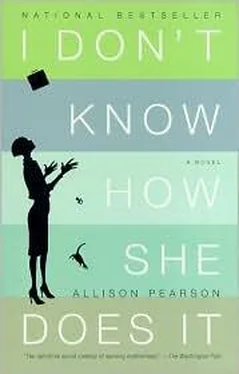Allison Pearson
I Don't Know How She Does It
juggle: v. & n. v. 1 intr. perform feats of dexterity, esp. by tossing objects in the air and catching them, keeping several in the air at the same time. 2 tr. continue to deal with (several activities) at once, esp. with ingenuity. 3 intr. & tr. (foll. by with) a deceive or cheat. b misrepresent (facts). c rearrange adroitly. n. 1 a piece of juggling. 2 a fraud.
Concise Oxford Dictionary
For Evie
with love
MONDAY, 1:37 A.M. How did I get here? Can someone please tell me that? Not in this kitchen, I mean in this life. It is the morning of the school carol concert and I am hitting mince pies. No, let us be quite clear about this, I am distressing mince pies, an altogether more demanding and subtle process.
Discarding the Sainsbury luxury packaging, I winkle the pies out of their pleated foil cups, place them on a chopping board and bring down a rolling pin on their blameless floury faces. This is not as easy as it sounds, believe me. Hit the pies too hard and they drop a kind of fat-lady curtsy, skirts of pastry bulging out at the sides, and the fruit starts to ooze. But with a firm downward motion — imagine enough pressure to crush a small beetle — you can start a crumbly little landslide, giving the pastry a pleasing homemade appearance. And homemade is what I’m after here. Home is where the heart is. Home is where the good mother is, baking for her children.
All this trouble because of a letter Emily brought back from school ten days ago, now stuck on the fridge with a Tinky Winky magnet, asking if “parents could please make a voluntary contribution of appropriate festive refreshments” for the Christmas party they always put on after the carols. The note is printed in berry red and at the bottom, next to Miss Empson’s signature, there is a snowman wearing a mortarboard and a shy grin. But do not be deceived by the strenuous tone of informality or the outbreak of chummy exclamation marks!!! Oh, no. Notes from school are written in code, a code buried so cunningly in the text that it could only be deciphered at Bletchley Park or by guilty women in the advanced stages of sleep deprivation.
Take that word “parents,” for example. When they write “parents” what they really mean, what they still mean, is mothers . (Has a father who has a wife on the premises ever read a note from school? Technically, it’s not impossible, I suppose, but the note will have been a party invitation and, furthermore, it will have been an invitation to a party that has taken place at least ten days earlier.) And “voluntary”? “Voluntary” is teacher-speak for “On pain of death and/or your child failing to gain a place at the senior school of your choice.” As for “appropriate festive refreshments,” these are definitely not something bought by a lazy cheat in a supermarket.
How do I know that? Because I still recall the look my own mother exchanged with Mrs. Frieda Davies in 1974, when a small boy in a dusty green parka approached the altar at Harvest Festival with two tins of Libby’s cling peaches in a shoe box. The look was unforgettable. It said, What kind of sorry slattern has popped down to the Spar on the corner to celebrate God’s bounty when what the good Lord clearly requires is a fruit medley in a basket with cellophane wrap? Or a plaited bread? Frieda Davies’s bread, maneuvered the length of the church by her twins, was plaited as thickly as the tresses of a Rhinemaiden.
“You see, Katharine,” Mrs. Davies explained later, doing that disapproving upsneeze thing with her sinuses over teacakes, “there are mothers who make an effort like your mum and me. And then you get the type of person who”—prolonged sniff—“don’t make the effort.”
Of course I knew who they were: Women Who Cut Corners. Even back in 1974, the dirty word had started to spread about mothers who went out to work. Females who wore trouser suits and even, it was alleged, allowed their children to watch television while it was still light. Rumors of neglect clung to these creatures like dust to their pelmets.
So before I was really old enough to understand what being a woman meant, I already understood that the world of women was divided in two: there were proper mothers, self-sacrificing bakers of apple pies and well-scrubbed invigilators of the washtub, and there were the other sort. At the age of thirty-five, I know precisely which kind I am, and I suppose that’s what I’m doing here in the small hours of the thirteenth of December, hitting mince pies with a rolling pin till they look like something mother-made. Women used to have time to make mince pies and had to fake orgasms. Now we can manage the orgasms, but we have to fake the mince pies. And they call this progress.
“Damn. Damn. Where has Paula hidden the sieve?”
“Kate, what do you think you’re doing? It’s two o’clock in the morning!”
Richard is standing in the kitchen doorway, wincing at the light. Rich with his Jermyn Street pajamas, washed and tumbled to Babygro bobbliness. Rich with his acres of English reasonableness and his fraying kindness. Slow Richard, my American colleague Candy calls him, because work at his ethical architecture firm has slowed almost to a standstill, and it takes him half an hour to take the bin out and he’s always telling me to slow down.
“Slow down, Katie, you’re like that funfair ride. What’s it called? The one where the screaming people stick to the side so long as the damn thing keeps spinning?”
“Centrifugal force.”
“I know that. I meant what’s the ride called?”
“No idea. Wall of Death?”
“Exactly.”
I can see his point. I’m not so far gone that I can’t grasp there has to be more to life than forging pastries at midnight. And tiredness. Deep-sea-diver tiredness, voyage-to-the-bottom-of-fatigue tiredness; I’ve never really come up from it since Emily was born, to be honest. Five years of walking round in a lead suit of sleeplessness. But what’s the alternative? Go in to school this afternoon and brazen it out, slam a box of Sainsbury’s finest down on the table of festive offerings? Then, to the Mummy Who’s Never There and the Mummy Who Shouts, Emily can add the Mummy Who Didn’t Make an Effort. Twenty years from now, when my daughter is arrested in the grounds of Buckingham Palace for attempting to kidnap the king, a criminal psychologist will appear on the news and say, “Friends trace the start of Emily Shattock’s mental problems to a school carol concert where her mother, a shadowy presence in her life, humiliated her in front of her classmates.”
“Kate? Hello?”
“I need the sieve, Richard.”
“What for?”
“So I can cover the mince pies with icing sugar.”
“Why?”
“Because they are too evenly colored, and everyone at school will know I haven’t made them myself, that’s why.”
Richard blinks slowly, like Stan Laurel taking in another fine mess. “Not why icing sugar, why cooking ? Katie, are you mad? You only got back from the States three hours ago. No one expects you to produce anything for the carol concert.”
“Well, I expect me to.” The anger in my voice takes me by surprise and I notice Richard flinch. “So, where has Paula hidden the sodding sieve?”
Rich looks older suddenly. The frown line, once an amused exclamation mark between my husband’s eyebrows, has deepened and widened without my noticing into a five-bar gate. My lovely funny Richard, who once looked at me as Dennis Quaid looked at Ellen Barkin in The Big Easy and now, thirteen years into an equal, mutually supportive partnership, looks at me the way a smoking beagle looks at a medical researcher — aware that such experiments may need to be conducted for the sake of human progress but still somehow pleading for release.
Читать дальше












